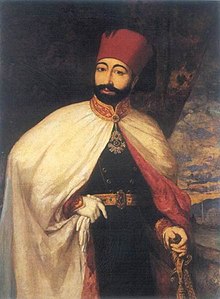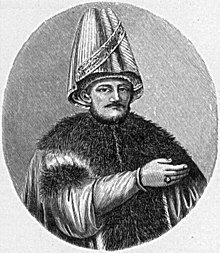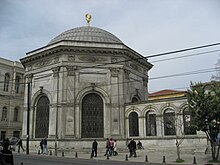Mahmud II
Mahmud II ( Ottoman محمود ثاني Mahmud-ı sānī ; * July 20, 1785 in Istanbul ; † July 1, 1839 ibid) was Sultan of the Ottoman Empire from 1808 to 1839 . During his reign the autonomy of Serbia and the independence of Greece fall . The Egyptian governor Muhammad Ali Pasha managed to expand his influence at the expense of the central government. On the other hand, numerous reforms fall during his reign. By violently smashing the Janissaries , he opened the way to building a modern army . Domestically, he strove to strengthen the central power and tried to reform the Ottoman Empire by creating pre-constitutional advisory bodies and institutions based on the European model.
Origin and youth
Mahmud was a son of Abdülhamid I. His mother, the Valide Sultan Nakşidil, is said to have been identical to the aristocratic French harem slave Aimée du Buc de Rivéry , but there is no evidence of this legend. He received a certain education in the sultan's palace. Mahmud was also interested in those of his cousin Selim III. initiated military reforms. His Mahlas (poet's name) was Adlî ( The Righteous ).
State crisis
Realizing that the traditional troops of the Ottoman Empire were no longer up to the modern European armies, Selim created with the Nizâm-ı Cedîd /نظام جديد / 'New Order' units based on the European model. This was financed through financial reforms. The financial burdens led to dissatisfaction among the population. The Janissaries , in particular, felt marginalized. With the loss of Medina to the Wahhabis in 1804 , the sultan also suffered a considerable loss of prestige. This was the background for the national crisis of 1807/08; by an uprising in Istanbul, the then Sultan Selim III. discontinued, but this had already ended the experiment of the new order.
The deposed Sultan was followed for a short time by Mahmud's brother as Mustafa IV , who tried to reverse all reforms. Thereupon the commander Alemdar Mustafa Pascha (also called Mustafa Bayraktar ), a staunch supporter of the reforms, marched with his units on Istanbul. During the siege of the palace by the Pasha, the Sultan let his predecessor Selim III. killing it, however, Mahmud was only lucky enough to escape.
Beginning of the reign
After his brother's dismissal, he became sultan and appointed Alemdar Mustafa Pasha Grand Vizier . He tried hard to prevent further uprisings in Istanbul. The military reforms were also resumed under a new name. In 1808, the Grand Vizier concluded an agreement on behalf of the central government, the Sened-i ittifak, with leading notables (members of the upper social class) of the various regions . This was an attempt to find a balance of interests. However, Muhammad Ali Pasha from Egypt, who was striving for independence, was not present. Sultan Mahmud had not signed the treaty either. It could therefore not become a permanent basis for relations between headquarters and the regions.
Despite the terror regime of the Grand Vizier, there was another uprising of the Janissaries in Istanbul in November 1808. The Grand Vizier was killed in this uprising. In this context, the Sultan had his predecessor Mustafa murdered, so that there was only one male member of the Osman family. For the first time in centuries, the continued existence of the rule of the Sultan's house was at times seriously questioned. Ultimately, however, Mahmud was able to hold onto the throne. In the following decades he tried to strengthen the influence of the central power again, but did not see himself in a position to take serious action against the influence of the Janissaries. Between 1811 and 1822, Hâlet Efendi was the leading politician without being a grand vizier.
Internal stabilization attempts

Another war against Russia had broken out under Mahmud's predecessors . This revived in 1809 and in 1810 led to the loss of further areas in what would later become Bulgaria . Ottoman counter-attacks, on the other hand, were not very successful. In the Treaty of Bucharest in 1812, Bessarabia fell to Russia. In return, the Ottoman Empire received the Romanian principalities of Moldova and Wallachia back.
However, some questions remained unanswered, e.g. B. in relation to the Russian claim to Poti and the Rioni Valley (Phasis) in the Caucasus . Therefore, during the Congress of Vienna (1814/15) there was no resolution on the integrity of the Ottoman state. The empire was only able to win back Serbia temporarily , before the country became autonomous after an uprising under Miloš Obrenović in 1815. However, the course of the border remained controversial until the 1830s. In some provinces, the government managed to enforce itself again. In 1814 Mostar in Bosnia was occupied. Between 1811 and 1814, with the help of Muhammad Ali Pascha, the Ottoman-Saudi war succeeded in smashing the first Saudi Arabian state. Between 1820 and 1822, the central government also succeeded in defeating the independence-striving Ali Pasha von Janina in the Balkans.
Greek revolution
Mahmud and the central government had underestimated the importance of the Greek independence movement, such as the Philiki Etaireia (Society of Friends). The beginning of the Greek Revolution in 1821 caught Mahmud completely unprepared during the struggle against Ali Pasha. At first he did not take the movement of the Greeks from Morea in southern Greece seriously. After the determination of the insurgents had become apparent, Mahmud is said to have briefly considered killing all Greeks in his empire. If this was not carried out, there were limited persecutions of the Greeks. In 1822 the Chios massacre took place, killing 25,000 and selling 45,000 Greeks as slaves. Although the Patriarch Gregorios of Constantinople excommunicated the insurgents and thus demonstrated loyalty to the Ottoman throne, he was executed. Other influential Greek people were killed in parts of the empire. In some cases, pogroms and acts of war on both sides merged.
A considerable part of the Ottoman fleet, most of which had Greek garrisons, went over to the rebels. The Greeks achieved great successes at sea, for example in the Battle of Spetzä (1822). Overall, however, the Greek military situation deteriorated rapidly. This became particularly evident when Muhammad Ali Pasha of Egypt (then the Ottoman Empire) came to the aid of the Sultan. The disciplined Egyptian army and the well-organized fleet made a lasting impression on the Turkish leadership. The allies managed to largely defeat the Greeks on the mainland by 1826.
Annihilation of the Janissaries and military reforms
Impressed by the Egyptian units, Mahmud II began in 1826 with the establishment of a modern army, initially in connection with the traditional units. In contrast, the janissary troops rose in Constantinople. In a bloody massacre, officially known as a “charitable event”, these troops were destroyed in their barracks with modern artillery. The resistance of the Janissaries in the provinces was also quickly broken. The sultan also weakened the heterodox religious brotherhoods that were close to the Janissaries. The old troops were to be replaced by a new, modern army under the name Asâkir-i Mansure-i Muhammediye /عساكر منصوره محمديه / Enter ' Victorious Army of Muhammad '. However, the implementation of the plans was incomplete. Since then, non-Turkish population groups have also been able to join the army. The new, but poorly trained and poorly equipped army, with 35,000 regular troops and a further 20,000 irregular troops, was very weak in comparison even with Egypt, let alone with the great powers.
Diplomacy and International Intervention
In addition to the military actions, diplomatic activities soon began on the "Greek question". After the assassination of the Greek Patriarch in Constantinople, Russia broke off its relations with the Ottoman Empire, and a pro-Greek mood prevailed in Great Britain from 1823. Negotiations between the great powers in 1824 and 1825 failed because Mahmud II refused to compromise on the Greek question. However, there was a temporary agreement with Russia in 1826. Since Mahmud did not want to negotiate about Greece despite various compromise offers, an alliance between France, Great Britain and Russia against the Ottoman Empire was formed in 1827.
In October Mahmud II asked Prince Metternich to mediate. This request came too late, however, because on October 20 the catastrophic defeat for the Turkish-Egyptian fleet in the Battle of Navarino occurred. The Ottoman Empire then broke off diplomatic relations with the intervention powers. In the war that followed, the Ottomans were ousted from the Morea Peninsula, the Cyclades, and other areas that were placed under Allied protection. The war ended with the Peace of Adrianople on September 14, 1829, and in the London Protocol of February 3, 1830, the Ottoman Empire had to recognize the independence of Greece. Algeria passed into French ownership that year. On the other hand, the Ottoman central government succeeded in rebuilding control of Albania, Bosnia and Baghdad around the same time.
First conflict with Muhammad Ali and unrest in the provinces
Muhammad Ali, who with Reformed Egypt had a much stronger power base than the Sultan, was appointed governor of Crete by him in 1830 . The expansion plans of Egypt became clear when Ibrahim Pasha , the son of Muhammad Ali, invaded Syria . Mahmud II then had father and son declared rebels. The Ottoman troops proved to be inferior, however, most recently in the Battle of Konya on February 20, 1832. In the Peace of Kütahya on May 4, 1832, Mahmud had to cede Syria and Cilicia to the Egyptians. Mahmud then allied himself with Russia. A Russian expedition to the Bosporus, the Treaty of Kütahya and the Treaty of Hünkâr İskelesi (July 8, 1833) followed. Under the de facto protectorate of Russia, Mahmud was initially able to stabilize his rule. Albania and Bosnia remained uneasy, where new uprisings broke out since 1835. In contrast, the central government succeeded in renewing its influence over Tripolitania from 1835 onwards . In view of the French threat from Algiers, Tunis also moved closer to the Reich again.
Reform policy
The army's defeats had made clear the need for further reforms. Provincial militia were formed in 1834. The Turkish fleet was rebuilt by American shipbuilding experts after Navarino. The first steamships were also launched. The tactical and strategic training was in the hands of British instructors. Since 1842, English has been the language of instruction in Turkish naval schools. Since 1836/37 Prussian military experts such as Helmuth von Moltke came to the country again, from whom extensive reports on the Ottoman Empire originate.
At the same time Mahmud began to set signs for an opening. In 1837 he made the first trip to the European part of the empire. With that he ended the tradition of self-isolation of the sultans behind the walls of the palace. In the same year the Sultan was visited by the Prussian princes August and Adalbert and by Archduke Johann of Austria . A Greek embassy was set up in Constantinople and, conversely, an Ottoman consulate was opened in Salonika .
Mahmud began an ambitious reform policy internally. Since 1835, ministries responsible for the Sultan have been established according to the European model. The traditional office of grand vizier was abolished in 1838 in favor of the post of prime minister. However, this did not prove to be a permanent solution. A state post was introduced in 1834. A modern pay regulation for civil servants was enacted in 1838. A government gazette was founded as early as 1831 and dress reforms were decreed in 1828 . In 1838 the High Council for Statutory Orders was established and an authority for secular education was established. In the time of Mahmud II, an education memorandum falls in 1839 that sharply criticized the Koran schools . In 1838 he concluded a trade agreement with Great Britain, which was later followed by similar treaties with other states.
In 1828 he founded the first medical school in the Ottoman Empire, the Mekteb-i Tıbbiye-i Şahane , and in 1838 the Mekteb-i Maarif-i Adliye, a school for the training of civil servants.
Second conflict with Muhammad Ali and death
When Muhammad Ali claimed the hereditary governorship not only for Egypt, Palestine and today's Lebanon, which Mahmud II was ready to accept, but also claimed this for all other provinces held, the conflict broke out again. In 1839, Muhammad Ali was declared a rebel again. Again the sultan's troops proved to be inferior to those of Egypt and were defeated on June 24, 1839 at the Battle of Nizip . When the news of the defeat reached Constantinople, the Sultan was already dying. He passed away on July 1, 1839. His mausoleum ( Türbe ) is located on Divan Yolu Prospekt in the Eminönü district of Istanbul. His successor was his son Abdülmecid I , who was only 16 years old at the time.
reception
literature
- Maurizio Costanza, La Mezzaluna sul filo - La riforma ottomana di Mahmûd II , Marcianum Press, Venezia, 2010, ISBN 978-88-6512-032-3
- Hans-Jürgen Kornrumpf: Mahmud II . In: Biographical Lexicon on the History of Southeast Europe . Volume 3. Göttingen 1979, pp. 71-73. books.google.de
- Klaus Kreiser: The last Ottoman century . In: Klaus Kreiser, Christoph K. Neumann: Small history of Turkey . Bonn 2005, ISBN 3-89331-654-X , pp. 315–382 (v. A. Pp. 320–330)
- Ernst Münch : Mahmud II. Padishah of the Ottomans. His life, his government and his reforms, together with glimpses of the immediate present and the future of the Turkish Empire . Krabbe, Stuttgart 1839, digitized version of the Bavarian State Library
- Christoph K. Neumann: The Ottoman Empire in its existential crisis. In: Klaus Kreiser, Christoph K. Neumann: Small history of Turkey . Bonn 2005, ISBN 3-89331-654-X , pp. 283-314
| predecessor | Office | successor |
|---|---|---|
| Mustafa IV. |
Sultan and Caliph of the Ottoman Empire 1808–1839 |
Abdülmecid I. |
| personal data | |
|---|---|
| SURNAME | Mahmud II |
| BRIEF DESCRIPTION | Sultan of the Ottoman Empire (1808–1839) |
| DATE OF BIRTH | July 20, 1785 |
| PLACE OF BIRTH | Constantinople |
| DATE OF DEATH | July 1, 1839 |
| Place of death | Constantinople |





